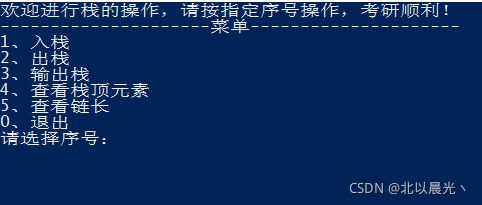数据结构-栈和队列(一)栈
第二章线性表文章跳转链接
数据结构-线性表(一)概念及基本操作
下篇文章
数据结构-栈和队列(二)队列
数据结构-栈和队列(三)栈和队列的应用
本文详细介绍了栈的基本概念和基本操作;以及顺序栈和链式栈的实现代码。Let’s go!♂️
数据结构
栈和队列(一)栈
思维导图
1 栈的基本概念
1、概念
栈(Stack) 是只允许在一端进行插入或删除操作的线性表
2、基本操作
线性表基本操作
InitList(&L): 初始化表。构造一个空的线性表L,分配内存空间。
DestroyList(&L): 销毁操作。销毁线性表,并释放线性表L所占用的内存空间。
ListInsert(&L,i,e): 插入操作。在表L中的第i个位置上插入指定元素e。
ListDelete(&L,i,&e): 删除操作。删除表L中第i个位置的元素,并用e返回删除元素的值。
LocateElem(L,e): 按值查找操作。在表L中查找具有给定关键字值的元素。
GetElem(L,i): 按位查找操作。获取表L中第i个位置的元素的值。
其他常用操作:
Length(L): 求表长。返回线性表L的长度,即L中数据元素的个数。
PrintList(L): 输出操作。按前后顺序输出线性表L的所有元素值。
Empty(L): 判空操作。若L为空表,则返回true,否则返回false。
栈的基本操作
InitStack(&S): 初始化栈。构造一个空栈 S,分配内存空间。
DestroyStack(&S):销毁栈。销毁并释放栈 S 所占用的内存空间。
Push(&S,x): 进栈,若栈S未满,则将x加入使之成为新栈顶。
Pop(&S,&x): 出栈,若栈S非空,则弹出栈顶元素,并用x返回。
GetTop(S, &x): 读栈顶元素。若栈 S 非空,则用 x 返回栈顶元素
其他常用操作:
StackEmpty(S): 判断一个栈 S 是否为空。若S为空,则返回true,否则返回false。
3、卡特兰数
2 顺序栈
#include3 链表栈
#include程序效果
新的一章开启!加油
下篇文章-数据结构-栈和队列(二)队列
数据结构-栈和队列(二)队列♂️









